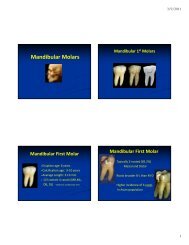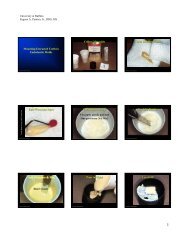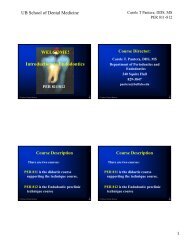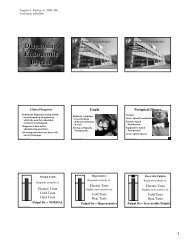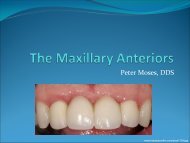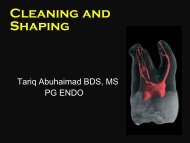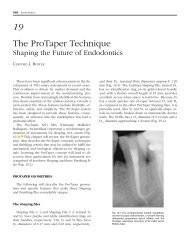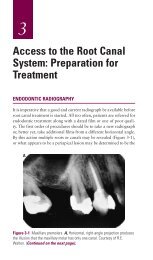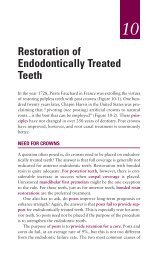Pulpal Diagnosis - University at Buffalo
Pulpal Diagnosis - University at Buffalo
Pulpal Diagnosis - University at Buffalo
You also want an ePaper? Increase the reach of your titles
YUMPU automatically turns print PDFs into web optimized ePapers that Google loves.
Eugene A. Pantera, Jr., DDS, MS<br />
Department of Periodontics and Endodontics<br />
Clinical <strong>Diagnosis</strong><br />
<strong>University</strong> <strong>at</strong> <strong>Buffalo</strong><br />
<strong>Pulpal</strong> <strong>Diagnosis</strong><br />
Endodontic Tre<strong>at</strong>ment is NOT Needed<br />
CLINICAL CLASSIFICATION SIGNS AND SYMPTOMS DIAGNOSTIC TEST RESULTS<br />
Normal<br />
A pulpal condition, usually called normal, in<br />
which the pulp responds to thermal and<br />
electrical tests in a manner similar to th<strong>at</strong> of a<br />
corresponding control tooth.<br />
Hypersensitive Dentin<br />
A pulpal condition, with no apparent<br />
histologic changes, in which the p<strong>at</strong>ient feels<br />
pain when the dentin is exposed to touch<br />
from a dental explorer, fingernail or tooth<br />
brush and to thermal or to other stimuli.<br />
However the pain disappears when the<br />
stimulus is removed.<br />
Reversible Pulpitis<br />
Syn: hyperemia, inflamed-reversible.<br />
A pulpal condition commonly induced by<br />
dental caries and oper<strong>at</strong>ive procedures, in<br />
which the p<strong>at</strong>ient responds to thermal or<br />
osmotic stimuli, but the symptoms disappear<br />
when the etiology is elimin<strong>at</strong>ed.<br />
Pain<br />
No history of pain.<br />
None to mild to moder<strong>at</strong>e intensity<br />
Pain is non-spontaneous<br />
No pain with percussion<br />
Moder<strong>at</strong>e to sharp response to thermal, sweet, or<br />
sour stimuli; response subsides when<br />
stimulus is removed.<br />
Etiology<br />
Usually caries, defective restor<strong>at</strong>ion, restor<strong>at</strong>ive<br />
procedures, mechanical pulp exposures,<br />
tooth brush abrasion, tooth fracture,<br />
recent prophylaxis, or subgingival scaling<br />
and curettage.<br />
Radiology<br />
No radiographic evidence of pulp calcific<strong>at</strong>ions,<br />
internal resorption, or periapical changes.<br />
EPT<br />
Response is normal and not in extremes. Is<br />
generally in the same range as control<br />
teeth.<br />
Thermal Tests<br />
Usual, normal response, for dur<strong>at</strong>ion of the<br />
stimulus. Reaction may be severe, but<br />
BRIEF.<br />
Percussion and Palp<strong>at</strong>ion<br />
Neg<strong>at</strong>ive, no response.<br />
1
Eugene A. Pantera, Jr., DDS, MS<br />
Department of Periodontics and Endodontics<br />
<strong>Pulpal</strong> <strong>Diagnosis</strong><br />
Endodontic Tre<strong>at</strong>ment IS Needed<br />
CLINICAL CLASSIFICATION SIGNS AND SYMPTOMS DIAGNOSTIC TEST RESULTS<br />
Irreversible Pulpitis<br />
Irreversible pulpitis without periapical p<strong>at</strong>hosis<br />
A pulpal condition, usually caused by deep<br />
dental caries or restor<strong>at</strong>ions, in which<br />
spontaneous pain may occur or be<br />
precipit<strong>at</strong>ed by thermal or other stimuli.<br />
Radiographs show no periapical changes.<br />
The pain last for several minutes to hours.<br />
Irreversible pulpitis with periapical p<strong>at</strong>hosis<br />
A pulpal condition similar to above, but in<br />
which periapical or l<strong>at</strong>eral radiographic<br />
changes are evident.<br />
Pain<br />
May have acute or chronic symptoms.<br />
Sharp, exagger<strong>at</strong>ed, painful response to thermal<br />
stimulus; pain lingers after stimulus is<br />
removed.<br />
Pain may be spontaneous; maybe past repe<strong>at</strong>ed<br />
episodes of pain, often continuous pain.<br />
Pain with mastic<strong>at</strong>ion.<br />
Etiology<br />
Deep caries and/or restor<strong>at</strong>ions, evidence of<br />
previous pulp cap.<br />
Exposed dentin (<strong>at</strong>trition, abrasion, and erosion).<br />
Traum<strong>at</strong>ic injuries.<br />
Resorption (especially perfor<strong>at</strong>ing).<br />
Orthodontic forces.<br />
EPT<br />
Tooth may test within normal limits.<br />
Response may be markedly different from<br />
control, rapid/delayed onset, persistent, and<br />
may be of severe intensity.<br />
Thermal Test<br />
A key factor in making a diagnosis.<br />
May be abnormal, rapid/delayed onset, gre<strong>at</strong>er<br />
intensity and longer dur<strong>at</strong>ion.<br />
Percussion Test<br />
May or may not be positive.<br />
Palp<strong>at</strong>ion<br />
May or may not be positive.<br />
Radiology<br />
May be normal.<br />
Radiographic evidence may reveal normal pulp,<br />
calcific<strong>at</strong>ions, narrow pulp chamber,<br />
"calcified" canals, , or condensing osteitis.<br />
An enlarged PDL may also be present.<br />
2
Eugene A. Pantera, Jr., DDS, MS<br />
Department of Periodontics and Endodontics<br />
<strong>Pulpal</strong> <strong>Diagnosis</strong><br />
Endodontic Tre<strong>at</strong>ment IS Needed<br />
CLINICAL CLASSIFICATION SIGNS AND SYMPTOMS DIAGNOSTIC TEST RESULTS<br />
Necrotic Pulp<br />
Necrotic pulp without periapical p<strong>at</strong>hosis<br />
A pulpal condition in which there may or<br />
may not be spontaneous moder<strong>at</strong>e to severe<br />
pain or pain elicited by various stimuli.<br />
Response to various testing modalities is<br />
usually absent. Radiographic changes are not<br />
evident.<br />
Necrotic pulp with periapical p<strong>at</strong>hosis<br />
A pulpal condition similar to above, except<br />
th<strong>at</strong> in this c<strong>at</strong>egory periapical or l<strong>at</strong>eral<br />
lesions are evident in radiographs.<br />
Pain<br />
May have acute or chronic symptoms.<br />
Pain may be spontaneous; maybe past repe<strong>at</strong>ed<br />
episodes of pain, often continuous, dull,<br />
throbbing, pain.<br />
Pain with mastic<strong>at</strong>ion.<br />
Etiology<br />
Deep caries and/or restor<strong>at</strong>ions, evidence of<br />
previous pulp cap.<br />
Carious pulp exposures.<br />
Exposed dentin (<strong>at</strong>trition, abrasion, and erosion).<br />
Traum<strong>at</strong>ic injuries.<br />
Resorption (especially perfor<strong>at</strong>ing).<br />
Orthodontic forces.<br />
EPT<br />
No response.<br />
May have false positives.<br />
Thermal Test<br />
No response.<br />
Percussion Test<br />
May or may not be positive.<br />
Palp<strong>at</strong>ion<br />
May or may not be positive.<br />
Radiology<br />
May be normal.<br />
May be periapical lesions or l<strong>at</strong>eral lesions.<br />
An enlarged PDL may also be present.<br />
3
Eugene A. Pantera, Jr., DDS, MS<br />
Department of Periodontics and Endodontics<br />
Periapical <strong>Diagnosis</strong><br />
There MAY be Need for Endodontic Tre<strong>at</strong>ment<br />
PULPAL DIAGNOSIS IS REQUIRED FOR DEFINITIVE DETERMINATION<br />
CLINICAL CLASSIFICATION SIGNS AND SYMPTOMS DIAGNOSTIC TEST RESULTS<br />
Acute Apical Periodontitis<br />
Pain<br />
History of pulpal pain.<br />
Moder<strong>at</strong>e to severe intensity th<strong>at</strong> may be<br />
intermittent.<br />
Periapical pain usually requires stimulus (eg<br />
mastic<strong>at</strong>ion).<br />
Pain can be sharp.<br />
Aggrav<strong>at</strong>ing factors are usually present.<br />
Etiology<br />
Irreversible pulpitis, traum<strong>at</strong>ic injuries,<br />
periodontal disease, orthodontic forces maxillary<br />
sinusitis, pressure from periapical tumors,<br />
restor<strong>at</strong>ion in hyperocclusion.<br />
Pulp Tests<br />
EPT and Thermal tests may be normal, or<br />
similar to irreversible pulpitis or pulpal<br />
necrosis.<br />
Percussion<br />
Moder<strong>at</strong>e to severe pain.<br />
Palp<strong>at</strong>ion<br />
Moder<strong>at</strong>e to severe pain.<br />
Radiology<br />
Usually thickening of PDL, also can have<br />
periapical or l<strong>at</strong>eral radiolucency, or normal.<br />
Chronic Apical Periodontitis<br />
A periapical condition characterized by none<br />
to slight pain on mastic<strong>at</strong>ion but may present<br />
itself with varying degrees of apical swelling.<br />
Radiographs reveal periapical or l<strong>at</strong>eral<br />
radiolucencies.<br />
Pain<br />
History of pain.<br />
Slight intensity to no pain. Pain may be absent or<br />
constant.<br />
Periapical pain can be spontaneous.<br />
Pain is dull throbbing.<br />
Pain can occur with mastic<strong>at</strong>ion.<br />
Etiology<br />
Same as for Acute apical periodontitis.<br />
Pulp Tests<br />
EPT and Thermal tests may be normal, or<br />
similar to irreversible pulpitis or pulpal<br />
necrosis.<br />
Percussion<br />
Moder<strong>at</strong>e to none.<br />
Palp<strong>at</strong>ion<br />
Moder<strong>at</strong>e to none. May be swelling.<br />
Radiology<br />
Periapical or l<strong>at</strong>eral radiolucency.<br />
4
Eugene A. Pantera, Jr., DDS, MS<br />
Department of Periodontics and Endodontics<br />
Periapical <strong>Diagnosis</strong><br />
There IS a Need for Endodontic Tre<strong>at</strong>ment<br />
PULPAL DIAGNOSIS IS REQUIRED FOR DEFINITIVE DETERMINATION<br />
CLINICAL CLASSIFICATION SIGNS AND SYMPTOMS DIAGNOSTIC TEST RESULTS<br />
Chronic Suppur<strong>at</strong>ive Apical Periodontitis<br />
A periapical condition characterized by non<br />
pain on mastic<strong>at</strong>ion. A draining sinus tract or<br />
other evidence of suppur<strong>at</strong>ion is evident.<br />
Radiographs reveal periapical or l<strong>at</strong>eral<br />
radiolucencies.<br />
Acute Alveolar Abscess<br />
Syn: Acute apical abscess<br />
An acute alveolar abscess is a severe clinical<br />
manifest<strong>at</strong>ion of periapical infectious<br />
disease, characterized by severe pain and<br />
swelling.<br />
Pain<br />
History of pain.<br />
Usually no pain present.<br />
Etiology<br />
Irreversible pulpitis, traum<strong>at</strong>ic injuries,<br />
periodontal disease, orthodontic forces,<br />
restor<strong>at</strong>ion in hyperocclusion.<br />
Pain<br />
History of pain.<br />
Severe intensity.<br />
Constant and spontaneous pain.<br />
Pain is pulsing and throbbing.<br />
Pain can occur with mastic<strong>at</strong>ion.<br />
Etiology<br />
The result of coronal apical progression of pulpal<br />
necrosis with resultant release of antigens into<br />
the periapical tissues.<br />
Pulp Tests<br />
EPT and Thermal tests may be normal, or<br />
similar to irreversible pulpitis or pulpal<br />
necrosis. (Is this a lesion of endodontic origin)<br />
Percussion<br />
None to slight pain.<br />
Palp<strong>at</strong>ion<br />
Slightly tender.<br />
Radiology<br />
Periapical or l<strong>at</strong>eral radiolucency.<br />
Visual<br />
Sinus tract present.<br />
Pulp Tests<br />
No response.<br />
Percussion<br />
Moder<strong>at</strong>e to severe.<br />
Palp<strong>at</strong>ion<br />
Moder<strong>at</strong>e to severe. Swelling probable.<br />
Radiology<br />
PDL thickening, periapical or l<strong>at</strong>eral<br />
radiolucency.<br />
5



